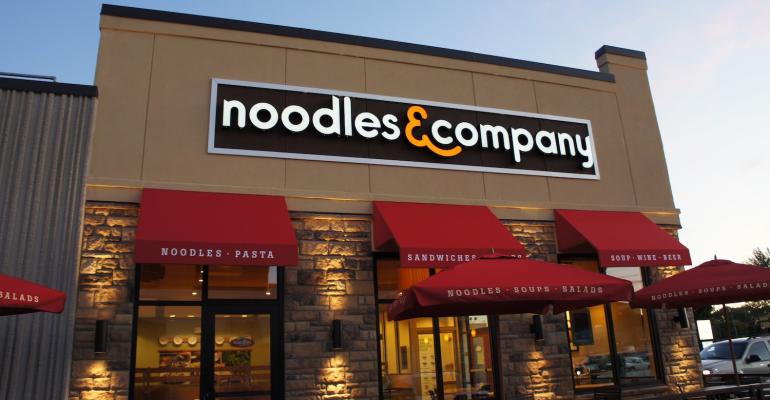Noodles & Company has gradually been raising prices over the past year, as many restaurants have, including a 5% increase in February, and their lower- and middle-income customers have finally started to push back, especially on delivery orders, executives of the 461-unit fast-casual chain told investors on Wednesday.
CEO Dave Boennighausen said delivery represented more than 30% of sales in the company’s first quarter, which ended on April 4, but “beginning during the last half of Q1, while dine-in sales continued to improve, we have seen a meaningful decline in delivery sales.”
Noodles & Company charges a 25% premium for third-party delivery orders.
He said the price increases made sense given rising commodity costs and other issues.
“Last year at this time we were seeing unprecedented inflation in the cost of many of our core products,” he said, particularly with chicken breast, which is the chain’s most popular protein.
“Combined with continued pressure and wage inflation, we encountered the most challenging expense environment that we have seen in decades.”
“While we feel our pricing strategy over the last 12 months was an appropriate approach to protect and ultimately expand margins, we had not anticipated the expense environment to improve as quickly as it did,” Boennighausen said. “Combined with the current consumer sentiment we ultimately have seen some consumer pushback on price, particularly with this most recent 5% price increase in February.”
Nonetheless, it was still a good quarter for the chain based in Broomfield, Colo. Revenue was up by 12% to $126.1 million, up from $112.6 million in the first quarter of 2022. Same-store sales were up by 6.4% systemwide, and average unit volumes were up by 7.5% year-over-year to $1.34 million.
That is due in part to the large percentage of high-income people who frequent the chain. Chief financial officer Carl Lukach said that 45% of Noodles & Company’s customers have household incomes of $100,00 or higher.
The company still did book a net loss of $3.1 million, or seven cents per share, but that was an improvement from the $6.4 million loss, 14 cents per share, in the first quarter of 2022.
Boennighausen said the company had undertaken several “cost saving and productivity initiatives” in 2022, including entering into a fixed contract for chicken for 2023 “at very favorable rates compared to 2022.”
Overall, the commodity picture looks much better for the coming year, and Boennighausen said he expects low-single-digit commodity deflation in the coming quarter.
And with food-cost pressure reduced, Noodles & Company is moving to provide more value for its guests.
A week ago Monday the chain brought back its 7 for $7 menu, offering seven entrées at that price, and it introduced a $10 mac & cheese menu, which includes the entrée plus a drink and its popular house-made Rice Krispie Treats.
“We have already seen a nice response to our value offerings, with sales stabilizing and traffic declines improving,” Boennighausen said.
Lukach said expected the chain to run “meaningfully lower prices through the remainder of the year.”
Meanwhile, management is still engaging in cost saving, margin-improving measures, including rolling out a menu with around 10% fewer items, which in test “yielded strong guest and operational metrics.” It has since been implemented systemwide.
The removal of those items has been strategic, Boennighausen said.
“We’re leaning into the customer favorites, which in today’s consumer environment we are just seeing guests gravitate towards,” he said.
“We’ve been able to identify through all of our data from the rewards membership program as well as other third-party sources that there were certain items that were potentially a little bit more difficult to execute … as well as had clear substitutes on the existing menu.”
For example, they removed their Orange Chicken, but the sales mix in the Asian category remained “exactly the same,” he said: Guests moved to the Japanese pan noodle, Korean beef or pad Thai. “And importantly, from the operational side, we saw significant cook-time improvements, [and] we saw better 90-day [employee] retention rates as people were able to be trained easier.”
Digital menu boards also are being rolled out, and they reduce the cost of testing menu items and allow the chain “to execute real-time marketing and pricing strategy,” the CEO said.
Noodles & Company also hired a third-party consultant to identify opportunities to streamline operations and reduce the footprint of future restaurant builds, Boennighausen said.
The chain plans to increase its gross number of units by about 7.5% this year, offset by the closure of around five underperforming locations as their leases expire, including two restaurants that will be closed in the second quarter.
He said six to seven new company-owned restaurants are expected to open in this quarter.
Three new company-owned restaurants opened in the first quarter.
Noodles & Company closed out the quarter with 369 company-owned restaurants and 92 franchised units, down from 93 at the beginning of the quarter.
Contact Bret Thorn at [email protected]





